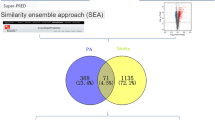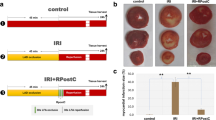Abstract
Ischemic stroke is one of the most vital causes of high neurological morbidity and mortality in the world. Preconditioning exercise is considered as the primary prevention of stroke to resistance to subsequent injury. We tried to research the underlying biological mechanisms of this exercise. Forty-two SD rats were randomly divided into three groups: middle cerebral artery occlusion (MCAO) group, exercise group with MCAO (EX + MCAO) group, and sham group, with 14 rats in each group. The EX + MCAO group underwent exercise preconditioning for 3 weeks before occlusion, and the other two groups were fed and exercised normally. After 3 weeks, MCAO model was made by thread plug method in the EX + MCAO group and MCAO group. After successful modeling, the Longa scale was used to evaluate the neurological impairment of rats at day 0, day 1, and day 2. The rats in each group were killed on the third day after modeling. TTC staining measured the infarct volume of each group. The morphology and apoptosis of cortical cells were observed by HE and Tunel staining. Three rats in each group underwent high-throughput sequencing. Bioinformatic analysis was used to find the deferentially expressed genes (DEGs) and predict the transcription factor binding sites (TFBS) of the next-generation sequencing results. Gene enrichment (GSEA) was used to analyze potential functional genes and their corresponding signaling pathways. The Longa scale showed EX + MCAO group had the neurological function better than the modeling group (P < 0.001). TTC staining showed that the infarct size of EX + MCAO group was less than MCAO group (P < 0.05). HE and Tunel staining showed that the cells in the EX + MCAO group and the sham group had normal morphology and fewer apoptotic cells than MCAO group. A new gene named 7994 was discovered and TFBS of this gene was predicted, which could interact with key genes such as Foxd3, Foxa2, NR4A2, SP1, CEBPA, and SOX10. GSEA showed that EX + MCAO group could promote and regulate angiogenesis and apoptosis through PI3K–AKT pathway. Preconditioning exercise could improve nerve function and reduce infarct size in rats. The underlying mechanism is to regulate the PI3K–AKT pathway through several key genes, promote cerebral angiogenesis, and reduce apoptosis.





Similar content being viewed by others
Data availability
The data used to support the findings of this study are available from the corresponding authors upon request. All reagents used in this study are available from scientific supply companies.
References
Abdalmalak A et al (2020) Using fMRI to investigate the potential cause of inverse oxygenation reported in fNIRS studies of motor imagery. Neurosci Lett 714:134607
Alim I et al (2019) Selenium drives a transcriptional adaptive program to block ferroptosis and treat stroke. Cell 177(5):1262-1279.e25
Baillieul S et al (2017) Hypoxic conditioning and the central nervous system: A new therapeutic opportunity for brain and spinal cord injuries? Exp Biol Med (maywood) 242(11):1198–1206
Bastian C et al (2018) NOS3 inhibition confers post-ischemic protection to young and aging white matter integrity by conserving mitochondrial dynamics and Miro-2 levels. J Neurosci 38(28):6247–6266
Diaz-Ruiz A et al (2014) Metallothionein-II inhibits lipid peroxidation and improves functional recovery after transient brain ischemia and reperfusion in rats. Oxid Med Cell Longev 2014:436429
Dong Y et al (2010) 14-3-3gamma and neuroglobin are new intrinsic protective factors for cerebral ischemia. Mol Neurobiol 41(2–3):218–231
Feng Y et al (2021) miR-1224 contributes to ischemic stroke-mediated natural killer cell dysfunction by targeting Sp1 signaling. J Neuroinflammation 18(1):133
Fischer AH et al (2008) Hematoxylin and eosin staining of tissue and cell sections. CSH Protoc 2008:pdb.prt4986
Fontenas, L. and S. Kucenas, Spinal cord precursors utilize neural crest cell mechanisms to generate hybrid peripheral myelinating glia. Elife, 2021. 10.
Gauthier J et al (2019) A brief history of bioinformatics. Brief Bioinform 20(6):1981–1996
Ghazavi H et al (2017) Fibroblast growth factor type 1 (FGF1)-overexpressed adipose-derived mesenchaymal stem Cells (AD-MSC(FGF1)) induce neuroprotection and functional recovery in a rat stroke model. Stem Cell Rev Rep 13(5):670–685
Guy JL, Mor GG (2021) Transcription Factor-Binding Site Identification and Enrichment Analysis. Methods Mol Biol 2255:241–261
Kapiainen E et al (2021) The amino-terminal oligomerization domain of angiopoietin-2 affects vascular remodeling, mammary gland tumor growth, and lung metastasis in mice. Cancer Res 81(1):129–143
Kinoshita K et al (2021) Mature adult mice with exercise-preconditioning show better recovery after intracerebral hemorrhage. Stroke 52(5):1861–1865
Lai X et al (2021) SOX10 ablation severely impairs the generation of postmigratory neural crest from human pluripotent stem cells. Cell Death Dis 12(9):814
Lang H et al (2020) Linc-FOXD3 knockdown enhances hippocampal NSCs activation through upregulation of the Wnt/β-catenin pathway. Neurosci Lett 729:134991
Langhorne P, Bernhardt J, Kwakkel G (2011) Stroke rehabilitation. Lancet 377(9778):1693–1702
Li Y, Zhang J (2021) Animal models of stroke. Animal Model Exp Med 4(3):204–219
Liu XL et al (2018) microRNA-137 promotes endothelial progenitor cell proliferation and angiogenesis in cerebral ischemic stroke mice by targeting NR4A2 through the Notch pathway. J Cell Physiol 233(7):5255–5266
Maida CD et al (2020) Neuroinflammatory mechanisms in ischemic stroke: focus on cardioembolic stroke, background, and therapeutic approaches. Int J Mol Sci 21(18):6454
Otsuka S et al (2016) The neuroprotective effects of preconditioning exercise on brain damage and neurotrophic factors after focal brain ischemia in rats. Behav Brain Res 303:9–18
Otsuka S et al (2019) Preconditioning exercise reduces brain damage and neuronal apoptosis through enhanced endogenous 14-3-3γ after focal brain ischemia in rats. Brain Struct Funct 224(2):727–738
Otsuka S et al (2021a) Preconditioning exercise in rats attenuates early brain injury resulting from subarachnoid hemorrhage by reducing oxidative stress, inflammation, and neuronal apoptosis. Mol Neurobiol 58(11):5602–5617
Otsuka S et al (2021b) Effects of detraining on preconditioning exercise-induced neuroprotective potential after ischemic stroke in rats. Brain Struct Funct 226(7):2169–2180
Otxoa-de-Amezaga A et al (2019) Microglial cell loss after ischemic stroke favors brain neutrophil accumulation. Acta Neuropathol 137(2):321–341
Pandian JD et al (2018) Prevention of stroke: a global perspective. Lancet 392(10154):1269–1278
Paul S, Candelario-Jalil E (2021) Emerging neuroprotective strategies for the treatment of ischemic stroke: An overview of clinical and preclinical studies. Exp Neurol 335:113518
Ren L, Wei C, Li K, Lu Z (2019) LncRNA MALAT1 up-regulates VEGF-A and ANGPT2 to promote angiogenesis in brain microvascular endothelial cells against oxygen-glucose deprivation via targetting miR-145. Biosci Rep 39(3):BSR20180226
Shamsaei N et al (2017) Neuroprotective effects of exercise on brain edema and neurological movement disorders following the cerebral ischemia and reperfusion in Rats. Basic Clin Neurosci 8(1):77–84
Shao Y et al (2020) Effect of Sox10 on remyelination of the hippocampus in cuprizone-induced demyelinated mice. Brain Behav 10(6):e01623
Teichert M et al (2017) Pericyte-expressed Tie2 controls angiogenesis and vessel maturation. Nat Commun 8:16106
Wei W et al (2021) Disorder genes regulate the progression of ischemic stroke through the NF-κB signaling pathway. Biomed Res Int 2021:2464269
White LJ, Castellano V (2008) Exercise and brain health–implications for multiple sclerosis: Part 1–neuronal growth factors. Sports Med 38(2):91–100
Zhang H, He L, Cai L (2018) Transcriptome Sequencing: RNA-Seq. Methods Mol Biol 1754:15–27
Zhu W et al (2019) MiR-222 inhibits apoptosis in porcine follicular granulosa cells by targeting the THBS1 gene. Anim Sci J 90(6):719–727
Zhu Y et al (2022) Insight into the mechanism of exercise preconditioning in ischemic stroke. Front Pharmacol 13:866360
Zito A et al (2021) Gene set enrichment analysis of interaction networks weighted by node centrality. Front Genet 12:577623
Zou Y et al (2020) Non-mitogenic fibroblast growth factor 1 enhanced angiogenesis following ischemic stroke by regulating the sphingosine-1-phosphate 1 pathway. Front Pharmacol 11:59
Funding
This study was supported by grants from Shanghai University of Medicine & Health Sciences Intelligent Neurorehabilitation Clinical Research Center (22MC2022002) and by Key Discipline Project of Shanghai Pudong New Area (PWZxk2022-10).
Author information
Authors and Affiliations
Contributions
Study design: XB, KL, and Z-KG; data analysis and manuscript drafting: KL and Z-KG; manuscript revision: KL, X-YS, YH, MY, and Y-SG; supervision of all experiments and data interpretation: XB. All authors have read and approved the manuscript.
Corresponding author
Ethics declarations
Conflict of interest
The authors of this manuscript have no conflicts of interest to disclose.
Ethical approval
This article does not contain any studies with human participants but animals. All applicable international, national, and/or institutional guidelines for the care and use of animals were followed. Approval was granted by Laboratory Animal Welfare and Ethics Committee, Shanghai University of Traditional Chinese Medicine. The review ethics number is: PZSHUTCM210305004.
Additional information
Communicated by Bill J Yates.
Publisher's Note
Springer Nature remains neutral with regard to jurisdictional claims in published maps and institutional affiliations.
Rights and permissions
Springer Nature or its licensor (e.g. a society or other partner) holds exclusive rights to this article under a publishing agreement with the author(s) or other rightsholder(s); author self-archiving of the accepted manuscript version of this article is solely governed by the terms of such publishing agreement and applicable law.
About this article
Cite this article
Li, K., Gao, ZK., Guo, YS. et al. Preconditioning exercise reduces brain damage of ischemic stroke in rats via PI3K–AKT pathway by bioinformatic analysis. Exp Brain Res 242, 869–878 (2024). https://doi.org/10.1007/s00221-024-06778-y
Received:
Accepted:
Published:
Issue Date:
DOI: https://doi.org/10.1007/s00221-024-06778-y




